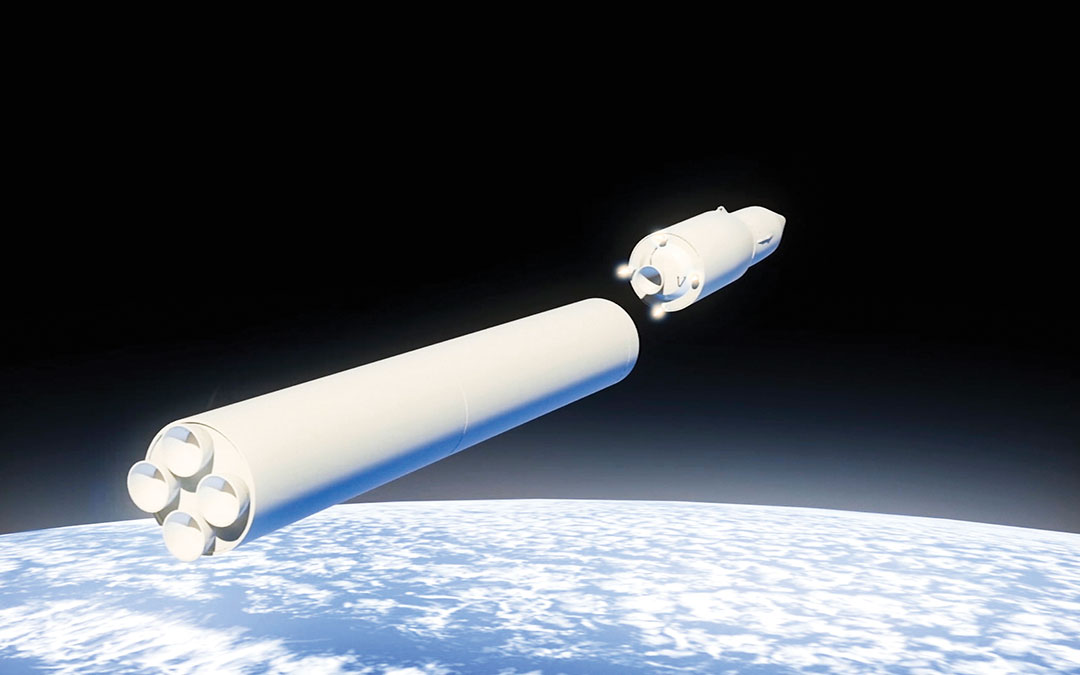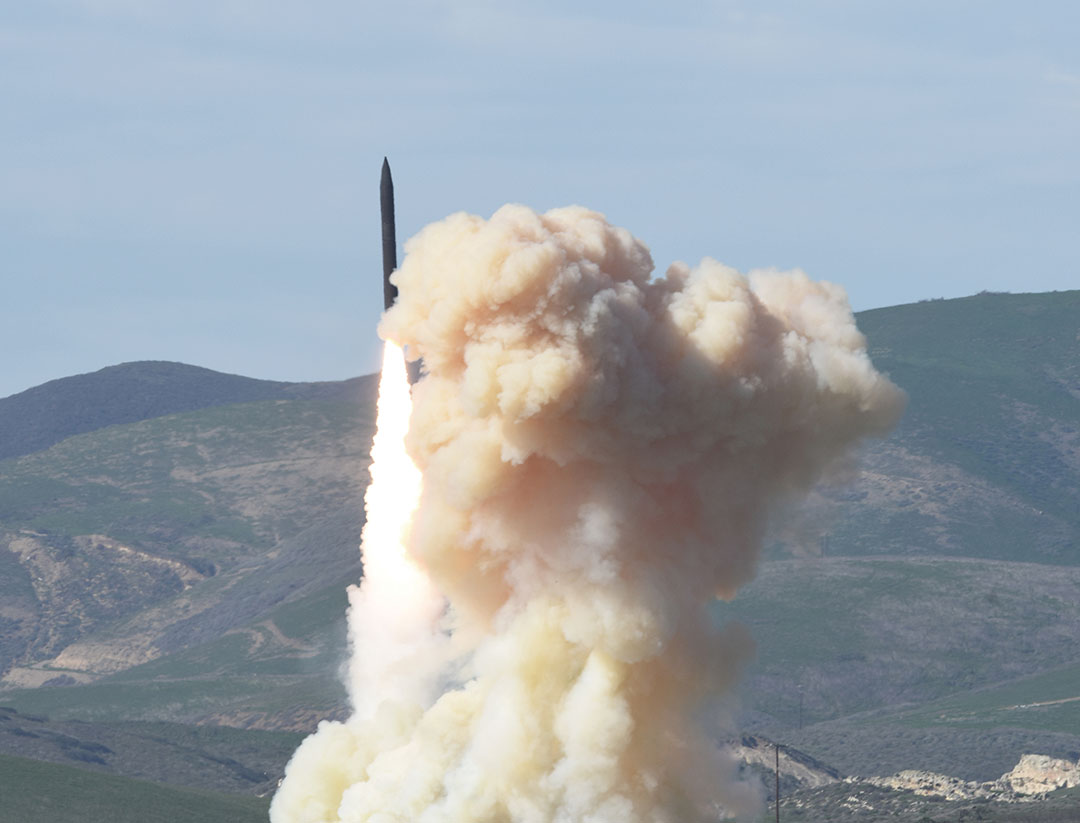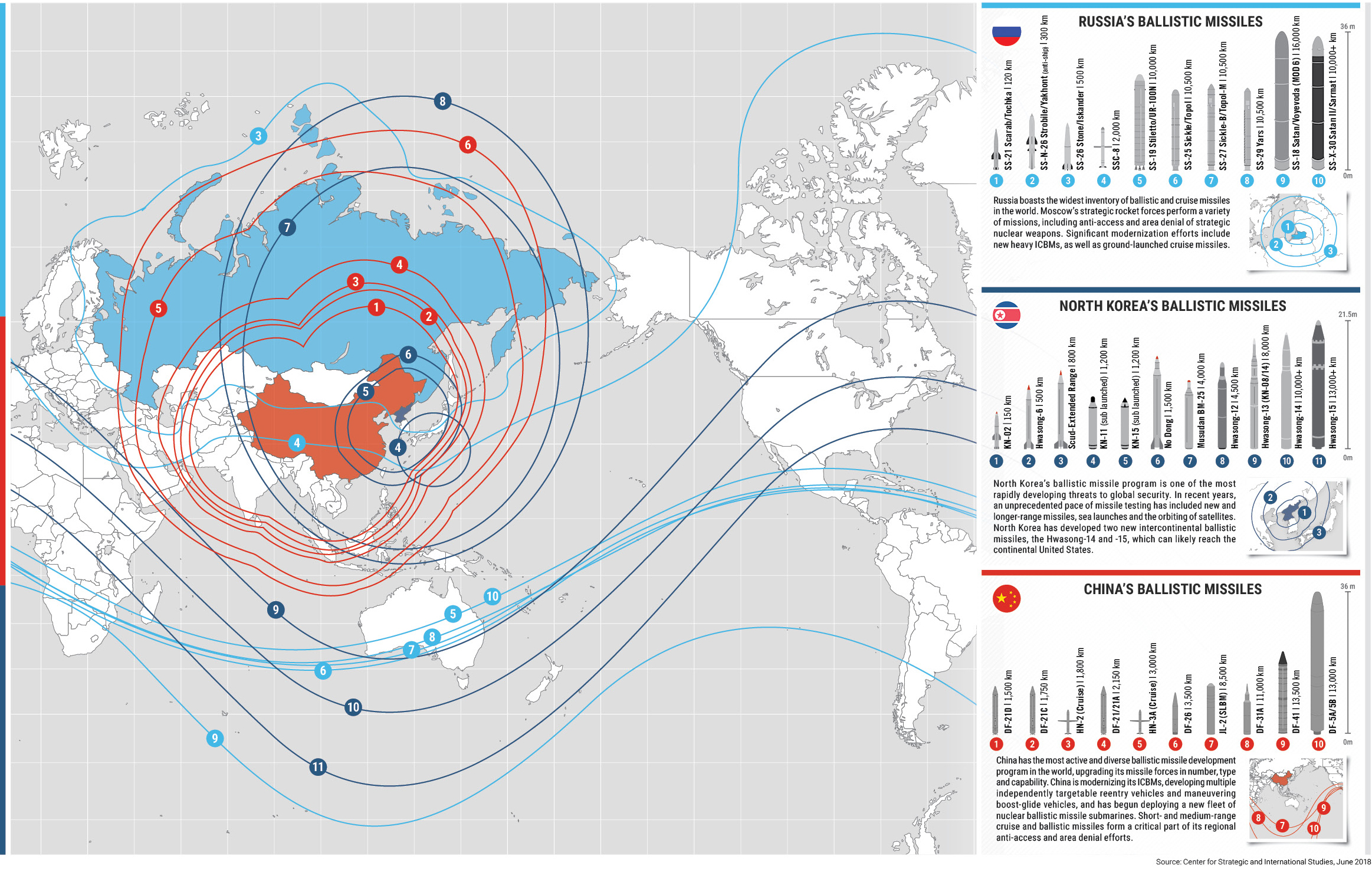A vigorous missile defense strategy is essential to security at home and abroad
THE WATCH Staff
In congressional testimony in 2019, top United States military officials painted a vivid picture of the evolving threats posed by hostile countries with missile stockpiles. Now more than ever, the military leaders said, the U.S. and its allies must maintain a technological advantage by upgrading the reliability and lethality of missile defense systems.
“The threats facing our nation are not hypothetical,” Gen. Terrence J. O’Shaughnessy, commander of the North American Aerospace Defense Command (NORAD) and U.S. Northern Command (USNORTHCOM), told the Senate Armed Services Committee. “Our competitors’ reach is now global, and they are conspicuously undermining international norms and standards of behavior while possessing the capability to strike targets in North America with both nuclear and advanced non-nuclear weapons launched from well beyond our territory.”
It was just three years ago that the U.S. celebrated a major success by shooting down a mock intercontinental ballistic missile (ICBM) fired from the Marshall Islands in a test of the military’s ground-based midcourse defense (GMD) system. For the first time, the system destroyed an ICBM-grade target in midair. The success was partly the result of a newly designed guidance system that steered an intercept vehicle into the path of the ICBM, destroying the incoming missile. It was proof that investments in technology can pay big dividends, something O’Shaughnessy emphasized in his testimony.
About 30 countries possess ballistic missiles, of which there are more than 35 variants. While political leaders navigate a diplomatic path to mitigating — or even eliminating — the threat of missile attacks, it remains essential that the U.S. Missile Defense Agency (MDA) continues to expand and perfect its ability to strike airborne threats before they reach our shores or those of our allies and friends.
“Diplomacy remains the lead,” O’Shaughnessy said at a gathering of allied air forces. “However, we have a responsibility to our allies and our nation to showcase our unwavering commitment while planning for the worst-case scenario.”
From Soviet bombers to ICBMs
That commitment began in the late 1950s with the creation of NORAD to prevent Soviet bombers from reaching the U.S. and Canada. Forty years later, Congress passed the National Defense Act to protect the U.S. from ICBMs. To support that mission, the MDA has spent U.S. $132 billion developing the GMD system to identify and intercept airborne threats. It plans to spend another U.S. $48 billion through 2022.
The goal is to create a system capable of protecting against a wide range of airborne threats — from modern strike aircraft and advanced air- and submarine-launched cruise missiles to small drones. The military will continue to enhance the sensors and guidance thrusters that detect and help destroy incoming missiles. The upgrades fit with the MDA’s mission statement to “develop and deploy a layered ballistic missile defense system to defend the U.S., its deployed forces, allies and friends from ballistic missile attacks of all ranges in all phases of flight.”
Today, the GMD system consists of 44 ground-based interceptors (GBIs) deployed in Alaska and California and connected to land-, sea- and space-based sensors. Technological upgrades are in constant development. “We are strengthening this system and investing in technologies to ensure that we can continue to counter rogue state missile threats to our homeland,” said John Rood, then undersecretary for policy for the U.S. Department of Defense.
A menacing threat matrix
It is a given that every advancement in missile defense technology will be countered by advancements in technologies to defeat those defenses. Today, airborne weapons are being designed to fly longer distances with more lethal payloads at altitudes and speeds that challenge detection systems.
“Hypersonic glide vehicles are being developed as a new type of ballistic missile payload,” then-MDA Director and U.S. Air Force Lt. Gen. Samuel A. Greaves told members of the House Armed Services Committee. “The combination of high speed, maneuverability and relatively low altitude makes them challenging targets for missile defense systems.”
In addition, electromagnetic jamming capabilities and cyber attacks are becoming ever greater threats, while marine launch systems are positioning missiles closer to the U.S. and Canada and to allies across the globe.
At the same time, long-standing threats grow in sophistication.
North Korea’s progress toward developing a nuclear-tipped missile that can reach the U.S. is well-documented, though diplomatic efforts may slow or even reverse its program.
Russia’s missile stockpile is varied and capable of reaching across the U.S. and Canada. It claims to have developed a hypersonic vehicle that can bypass intercept missiles and has already fired next-generation cruise missiles into Syria from ships and submarines. It is also developing stealthy naval platforms to defy detection. “Its new generation of air- and sea-launched cruise missiles feature significantly greater standoff ranges and accuracy than their predecessors, allowing them to strike North America from well outside NORAD radar coverage,” O’Shaughnessy said. These advancements represent a significant investment by Russia that is likely to put targets at risk in the United States and Canada for years to come.
China claims to have successfully tested a hypersonic aircraft that can reach speeds of 4,500 mph and is investing in mobile ICBMs and ballistic missile submarines. It is increasingly sending ships on intelligence gathering operations outside of its territorial waters, including near the U.S. And Iran has launched ballistic missile strikes in Syria and against U.S. forces in Iraq.

Investing in technology
To meet the threats, the MDA is improving its missile detection and engagement systems. Adversaries have developed weapons that release debris or decoys that can misdirect the intercept vehicles launched to destroy warheads. The MDA has developed a new radar system — the Long Range Discrimination Radar — that can better sort through the debris. It is one of many technological improvements in development, including lasers to intercept missiles during the boost phase and improved kill vehicles to destroy incoming payloads in space.
Additionally, more GBIs are being put into silos and positioned for firing against incoming threats. Congress appropriated U.S. $4 billion in 2018 to enhance missile defense capabilities against North Korean threats to the U.S. homeland, forces abroad, allies and partners. The funding means an additional 20 GBIs will be deployed in Alaska as early as 2023.
The ground-based Cobra Dane radar detection system in Alaska and the floating sea-based X-band radar designed to work in heavy seas, both essential to homeland defense, are also being improved.
Even more enhancements can be expected. The Department of Defense’s 2020 missile defense budget request “supports improving the current system and moving toward innovative concepts and advanced technologies,” Rood said. The request also continues the development of defense systems for short-range and midrange missile threats by including additional Patriot missiles and by enhancing the Terminal High Altitude Area Defense (THAAD) system and ship-based Aegis interceptor systems.
The key is maintaining a flexibility to respond to a crisis wherever it emerges. “We will continue to increase the reliability as well as the capability and capacity of … missile defense systems and make measured investments in advanced technology to counter the adversary missile threat,” Greaves said.

A vigorous strategy
For the MDA’s part, the focus remains on three main areas, as outlined by Greaves:
“Increasing system reliability by upgrading, improving and sustaining deployed systems and executing a rigorous and continuous test and evaluation approach with strong modeling and simulation to mature technologies and validated deployed capabilities.”
“Increasing engagement capability and capacity by increasing the number of fielded interceptors, building out the sensor architecture with the aim of capturing ‘birth-to-death’ tracking, improving system discrimination and integration, leveraging international partnerships for affordability and interoperability, and working closely with the combatant commands to provide integration support and capabilities to meet emergent operational needs.”
“Addressing the advanced threat by working with combatant commands and Services to address emerging threats, to include the growing and highly challenging hypersonic guide vehicle and cruise missile threats and by pursuing advanced technologies, such as directed energy (which inflicts damage by emitting laser, microwave or particle beams toward a target), and making prudent affordable investments potentially game-changing capabilities.”
Conclusion
Maintaining a muscular missile defense system is essential to protecting the U.S., Canada, and their allies and friends across the world. Overcoming the technological advances by adversaries requires a continuous investment in the systems designed to defeat those advances. The Department of Defense budget requests represent a strategy that protects the homeland while protecting overseas forces, allies and partners for years to come.
“Revisionist powers Russia and China have changed global strategic dynamics by fielding advanced long-range weapons systems and engaging in increasingly aggressive efforts to expand their global presence and influence, including in the approaches to the United States and Canada,” O’Shaughnessy testified. “The successful defense of our homeland today relies more than ever on constant vigilance by USNORTHCOM and NORAD, tightly coupled with a reinvigorated emphasis on close integration with our fellow combatant commands, the intelligence community, and our allies and partners.”


